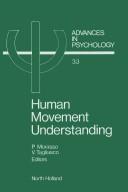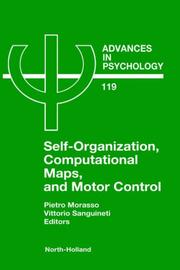| Listing 1 - 4 of 4 |
Sort by
|

ISBN: 0444700323 9786611797805 1281797804 0080866875 9780080866871 9780444700322 9781281797803 6611797807 Year: 1986 Volume: 33 Publisher: Amsterdam New York North-Holland
Abstract | Keywords | Export | Availability | Bookmark
 Loading...
Loading...Choose an application
- Reference Manager
- EndNote
- RefWorks (Direct export to RefWorks)
The volume applies to the study of the motor system the computational approach developed by David Marr for the visual system. Accordingly, understanding movement is viewed as an information processing problem, centred on the representation of appropriate computational structures. In particular, the book deals with the representation of objects, concurrent parallel processes, trajectory formation patterns and patterns of interaction with the environment.A number of modeling techniques are discussed, ranging from computational geometry to artificial intelligence, integrating very differe
Human mechanics --- Kinesiology --- Artificial intelligence --- Research --- Technique --- Mathematical models --- Kinetics. --- Models, Biological. --- Movement. --- 612.8 --- -Human mechanics --- -Kinesiology --- -Cinesiology --- Motor ability --- Body mechanics, Human --- Human biomechanics --- Human movements --- Movements, Human --- Animal mechanics --- Human physiology --- Physical anthropology --- AI (Artificial intelligence) --- Artificial thinking --- Electronic brains --- Intellectronics --- Intelligence, Artificial --- Intelligent machines --- Machine intelligence --- Thinking, Artificial --- Bionics --- Cognitive science --- Digital computer simulation --- Electronic data processing --- Logic machines --- Machine theory --- Self-organizing systems --- Simulation methods --- Fifth generation computers --- Neural computers --- Movements --- Motion --- Biological Model --- Biological Models --- Model, Biological --- Models, Biologic --- Biologic Model --- Biologic Models --- Model, Biologic --- Zenuwstelsel. Zintuigen. Motorische neurowetenschappen --- -Technique --- -Zenuwstelsel. Zintuigen. Motorische neurowetenschappen --- Kinetics --- Models, Biological --- Movement --- Cinesiology --- Research&delete& --- Artificial intelligence. --- Mathematical models. --- Technique. --- Human mechanics - Research - Technique --- Kinesiology - Research - Technique --- Human mechanics - Mathematical models

ISBN: 0444823239 9786611058340 1281058343 0080540910 9780080540917 9780444823236 9781281058348 6611058346 Year: 1997 Volume: 119 Publisher: Amsterdam New York Elsevier
Abstract | Keywords | Export | Availability | Bookmark
 Loading...
Loading...Choose an application
- Reference Manager
- EndNote
- RefWorks (Direct export to RefWorks)
In the study of the computational structure of biological/robotic sensorimotor systems, distributed models have gained center stage in recent years, with a range of issues including self-organization, non-linear dynamics, field computing etc. This multidisciplinary research area is addressed here by a multidisciplinary team of contributors, who provide a balanced set of articulated presentations which include reviews, computational models, simulation studies, psychophysical, and neurophysiological experiments. The book is divided into three parts, each characterized by a slightly different f
Sensorimotor cortex --- Locomotion --- Self-organizing systems --- Robotics --- Computer simulation --- 612.8 --- -Robotics --- Sensomotor cortex --- Cerebral cortex --- Learning systems (Automatic control) --- Self-optimizing systems --- Cybernetics --- Intellect --- Learning ability --- Synergetics --- Automation --- Machine theory --- Zenuwstelsel. Zintuigen. Motorische neurowetenschappen --- Sensorimotor cortex. --- Self-organizing systems. --- Robotics. --- Computer simulation. --- Locomotion - Computer simulation
Digital
ISBN: 9780080540917 0080540910 1281058343 9781281058348 9786611058340 6611058346 Year: 1997 Publisher: New York Elsevier
Abstract | Keywords | Export | Availability | Bookmark
 Loading...
Loading...Choose an application
- Reference Manager
- EndNote
- RefWorks (Direct export to RefWorks)
In the study of the computational structure of biological/robotic sensorimotor systems, distributed models have gained center stage in recent years, with a range of issues including self-organization, non-linear dynamics, field computing etc. This multidisciplinary research area is addressed here by a multidisciplinary team of contributors, who provide a balanced set of articulated presentations which include reviews, computational models, simulation studies, psychophysical, and neurophysiological experiments. The book is divided into three parts, each characterized by a slightly different focus: in part I, the major theme concerns computational maps which typically model cortical areas, according to a view of the sensorimotor cortex as "geometric engine" and the site of "internal models" of external spaces. Part II also addresses problems of self-organization and field computing, but in a simpler computational architecture which, although lacking a specialized cortical machinery, can still behave in a very adaptive and surprising way by exploiting the interaction with the real world. Finally part III is focused on the motor control issues related to the physical properties of muscular actuators and the dynamic interactions with the world. The reader will find different approaches on controversial issues, such as the role and nature of force fields, the need for internal representations, the nature of invariant commands, the vexing question about coordinate transformations, the distinction between hierachiacal and bi-directional modelling, and the influence of muscle stiffness.
Digital
ISBN: 9780080866871 0080866875 1281797804 9781281797803 9786611797805 6611797807 Year: 1986 Publisher: New York North-Holland
Abstract | Keywords | Export | Availability | Bookmark
 Loading...
Loading...Choose an application
- Reference Manager
- EndNote
- RefWorks (Direct export to RefWorks)
The volume applies to the study of the motor system the computational approach developed by David Marr for the visual system. Accordingly, understanding movement is viewed as an information processing problem, centred on the representation of appropriate computational structures. In particular, the book deals with the representation of objects, concurrent parallel processes, trajectory formation patterns and patterns of interaction with the environment. A number of modeling techniques are discussed, ranging from computational geometry to artificial intelligence, integrating very different aspects of movement, especially those which are not directly motoric.
| Listing 1 - 4 of 4 |
Sort by
|

 Search
Search Feedback
Feedback About UniCat
About UniCat  Help
Help News
News